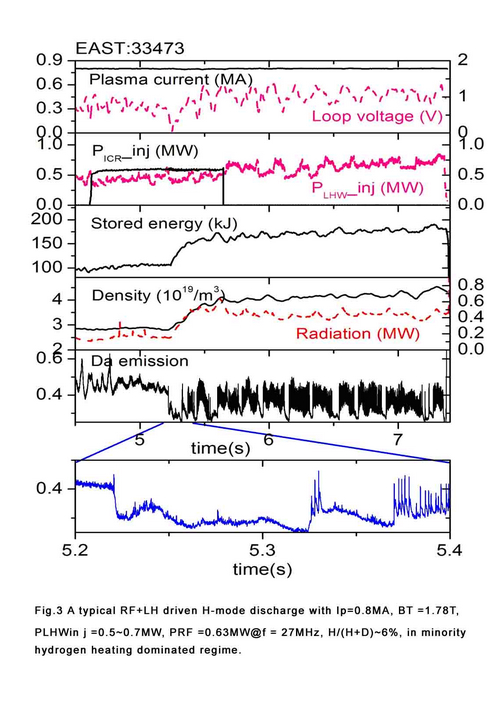Stationary H-mode plasmas have been achieved on EAST during the present H-mode campaign by either LHW alone or combination of RF and LHW. The H-mode campaign started on Sept.14. The principal goals are to investigate the efficiency of RF heating on minority hydrogen and the mode conversion scenario, and to explore existing capabilities for achieving H-mode plasmas and long pulse plasma operations. Lithium wall conditioning has routinely been used to reduce both impurity and hydrogen recycling.
The first H-mode plasma was achieved by LHW alone on Nov. 7, with the plasma current, Ip = 0.6MA, line averaged density, ne = 21019 m-3, and toroidal magnetic field, BT = 1.35T. LHW of 1 MW (source power) was applied in EAST, producing the ELM-free H-mode plasma with a relatively short period. Back transition from H- to L-mode was mainly due to increased radiation and LHW reflection during the H-mode phase.
Further efforts were made to reduce the radiation and improve the performance of the target plasma, including intensive lithium evaporation, suppressing run-away electrons during plasma current ramp-up and early shaping of the plasma into divertor configuration to reduce plasma radiation, localized gas puffing at the LH launcher to improve LHW coupling, high field side gas fuelling, etc. These reduced the L-H transition power threshold, allowing to achieve reproducible ELMy H-mode plasmas with LHW alone.

Figure 1 shows a typical H-mode plasma discharge with different ELM types in EAST, i.e., mixed type I & type III ELMs, and grassy ELMs. Stationary ELMy H-mode plasmas with LHW alone have been reproduced in a wide range of operation conditions with Ip=0.4~0.8MA, BT=1.3~2T, ne(target)=1.5~2.51019 m-3, PLHW(injection)=0.5~1MW, double null or near double null and single null (B drift towards x point) divertor configurations. Density profiles from microwave reflectometry clearly demonstrate pedestal formation at the onset of H-modes, as shown in Fig. 2.

ELMy H-modes have also successfully been achieved with the combination of LHW and ICRF heating. By the baking of PFC and extensive Li wall conditioning, H/(H+D) ratio can be controlled in the range of 6-10%. This enables effective ICRF heating in both electron and ion dominated heating scenarios with optimized plasma wave coupling. A typical shot with mixed type I & type III ELMs is shown in Fig. 3. Note that LHW power is needed to assist plasma building-up at higher current and density and to increase target plasma temperature, which is beneficial for ICRF power absorption.
More than 200 H-mode plasma discharges have been produced up to now, with many intriguing phenomena being observed under current specific conditions, i.e., with LHW, RF and Lithium wall-coating. Further analysis will be carried out. International contributions from USA (GA, PPPL, MIT, FRC), France (CEA), Japan (NIFS, JAEA), Korea (NFRI), Germany (IPP) are one of the key ingredients for these achievements.
